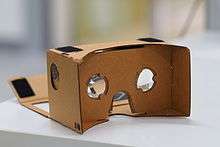360-degree video
360-degree videos, also known as immersive videos[1] or spherical videos,[2] are video recordings where a view in every direction is recorded at the same time, shot using an omnidirectional camera or a collection of cameras. During playback the viewer has control of the viewing direction like a panorama, a form of virtual reality.
Creation

360-degree video is typically recorded using either a special rig of multiple cameras, or using a dedicated VR camera that contains multiple camera lenses embedded into the device. The resulting footage is then stitched to form a single video. This process is done either by the camera itself, or using specialized video editing software that can analyze common visuals and audio to synchronize and link the different camera feeds together. Generally, the only area that cannot be viewed is the view toward the camera support.[4][5]
Specialized omnidirectional cameras and rigs have been developed for the purpose of filming 360-degree video, including rigs such as GoPro's Omni and Odyssey, and the Kodak Pixpro SP360 4K Dual Pack Pro (both of which consist of multiple action cameras installed into a single rig), the Vuze camera, handheld dual-lens cameras such as the Ricoh Theta S and Samsung Gear 360, and the Kogeto Dot 360—a panoramic camera lens accessory developed for the iPhone 4, 4S, and Samsung Galaxy Nexus.[6][7][3] In videoconferencing, 360° cameras are used, so that all participants on one location can be recorded with one camera.[8][9]
Playback

Most 360-degree video is monoscopic, meaning that it is viewed as a flat image on a singular surface. Stereoscopic video is viewed as two images directed individually to each eye.[4] 360-degree videos are typically viewed via personal computers, mobile devices such as smartphones, or dedicated head-mounted displays. When viewed on PCs, the mouse is typically used to pan around the video by clicking and dragging. On smartphones, internal sensors such as the gyroscope is used to pan the video based on the orientation of the device. Taking advantage of this behavior, devices such as Google Cardboard viewers and the Samsung Gear VR serve as stereoscope-style headset enclosures that a smartphone can be inserted into, for viewing this content in a virtual reality format. They emulate the operation of a dedicated head-mounted display, but utilizing the display of the phone itself and internal lenses, rather than containing dedicated screens of their own.[4][10][11]
Publishing
In March 2015, YouTube officially launched the ability for users to view upload 360-degree videos, with playback on its website and its Android mobile apps. Parent company Google also announced that it would collaborate with VR camera manufacturers to make it easier for creators to upload 360-degree content recorded with their products to YouTube.[10] Facebook (parent company of VR headset maker Oculus VR) followed suit in September 2015.[2]
Google Cardboard, which is typically distributed in the form of do-it-yourself kits consisting of low-cost materials and components,[12] has been credited with helping virtual reality become more readily available to the general public, and helping boost the adoption of 360-degree video by publishers, such as mainstream journalists and media brands.[13]
References
- ↑ "With Google's new immersive videos, you can feel what it's like to be a ballet dancer". Quartz. Retrieved 12 July 2016.
- 1 2 Etherington, Darrell (March 25, 2015). "Facebook To Support Spherical Video In News Feed And Oculus". TechCrunch. Retrieved March 14, 2016.
- 1 2 "Ricoh Theta S review". CNET. CBS Interactive. Retrieved 12 July 2016.
- 1 2 3 "10 things I wish I knew before shooting 360 video". CNET. CBS Interactive. Retrieved 12 July 2016.
- ↑ Maher, Michael (October 2, 2015). "How to Shoot, Edit, and Upload 360-Degree Videos". The Beat. Retrieved March 14, 2016.
- ↑ Sam Byford (January 6, 2012). "Kogeto iCONIC panoramic video coming to Galaxy Nexus and more". The Verge. Retrieved February 24, 2016.
- ↑ "360-degree cameras: The best VR cams, no matter your budget". Pocket-lint. Retrieved 12 July 2016.
- ↑ A Microsoft RoundTable 360° camera
- ↑ "Omni-directional camera design for video conferencing".
- 1 2 "You Can Now Watch and Upload 360-Degree Videos on YouTube". Wired. Retrieved 12 July 2016.
- ↑ "Best VR headsets to buy in 2016, whatever your budget". Pocket-lint. Retrieved 12 July 2016.
- ↑ Fingas, Jon (February 29, 2016). "Google starts selling Cardboard VR viewers through its store". Engadget. AOL. Retrieved April 3, 2016.
- ↑ Scott, Caroline (February 19, 2016). "How to get involved in the rise of 360-degree video". Journalism.co.uk. Retrieved March 14, 2016.